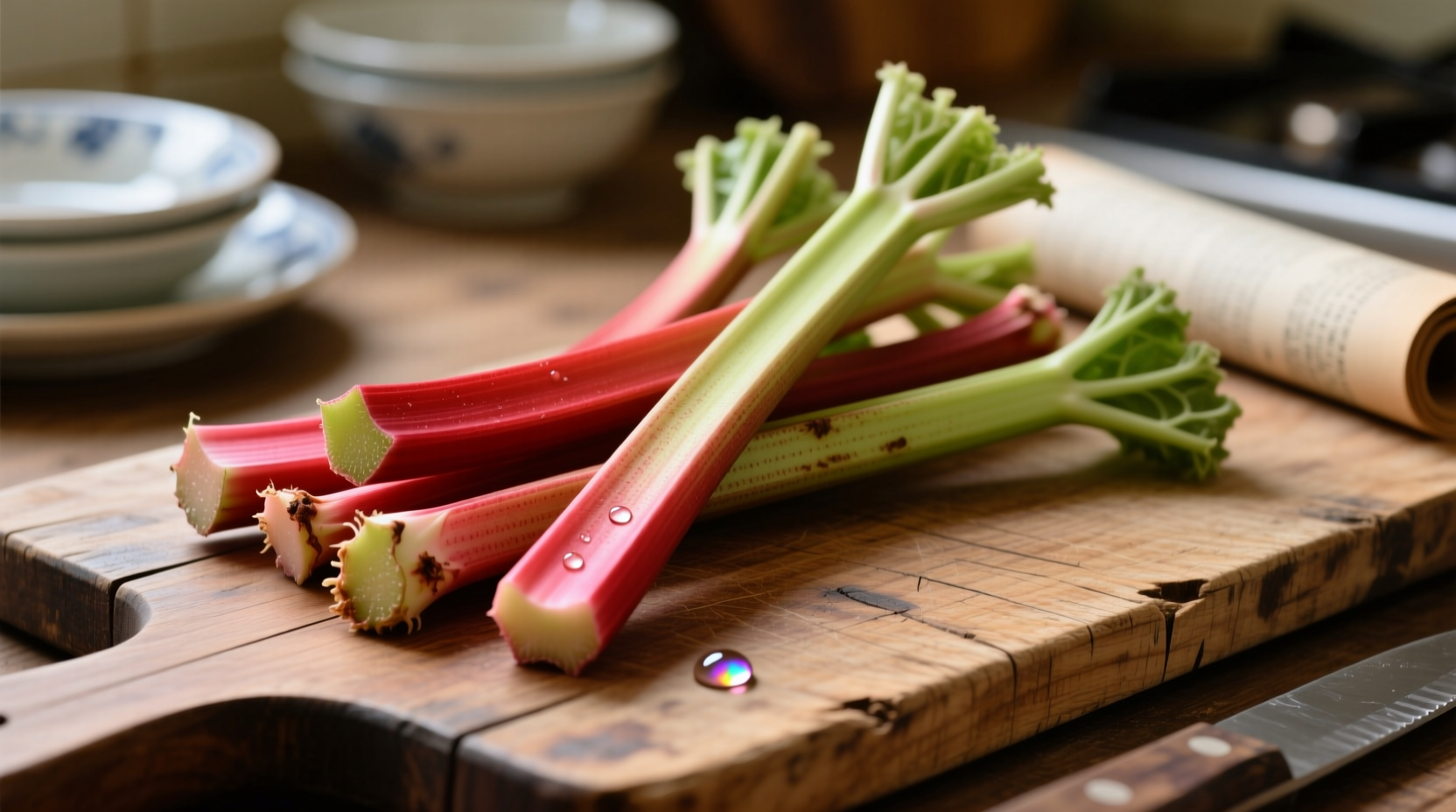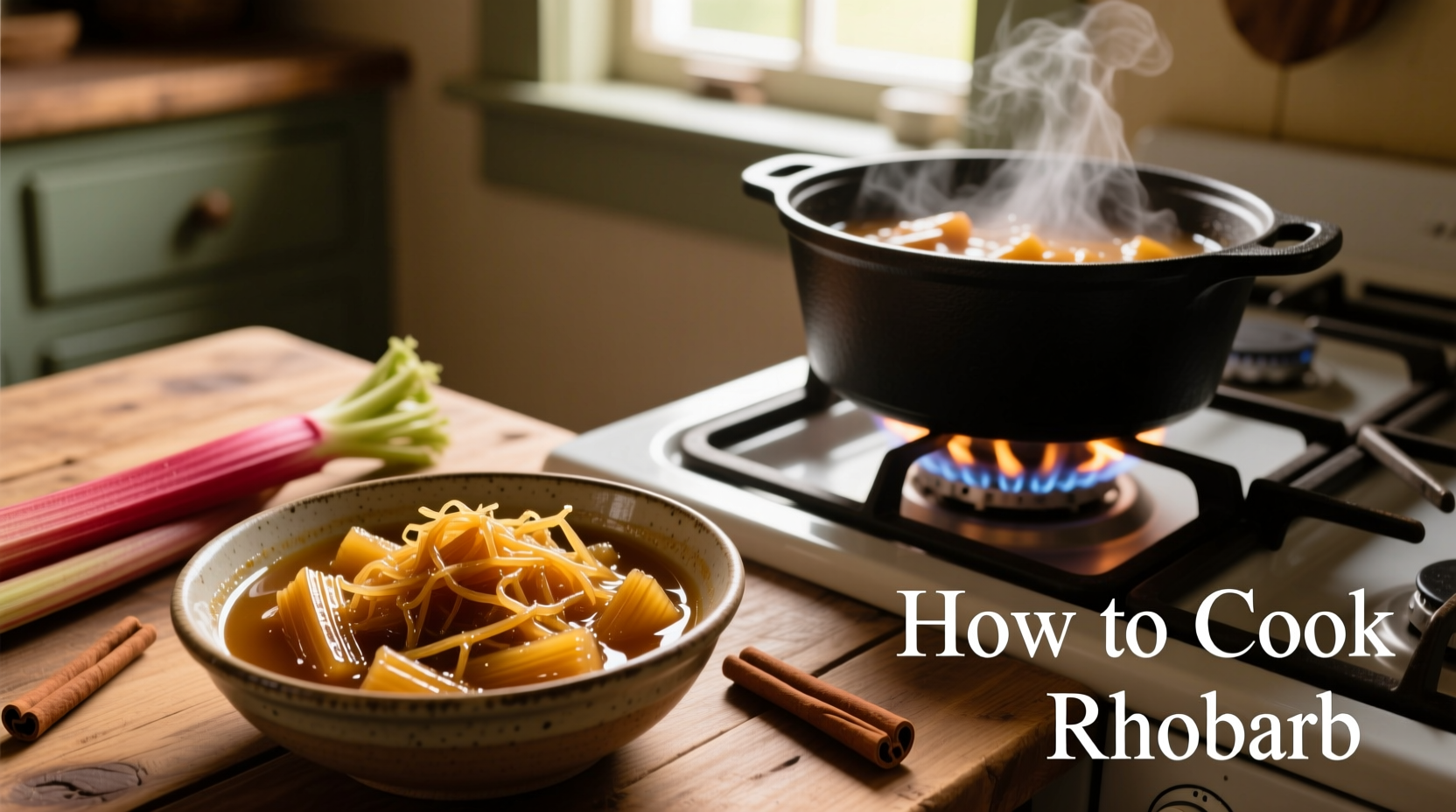Discover exactly how to transform this famously tart vegetable into delicious dishes with our step-by-step guide. Whether you've harvested your first rhubarb stalks or bought them at the market, you'll learn professional techniques to prepare, cook, and enjoy rhubarb safely and deliciously.
Understanding Rhubarb: What You Must Know First
Rhubarb isn't technically a fruit—it's a vegetable with culinary fruit status. More importantly, only the stalks are edible. The leaves contain high levels of oxalic acid, making them toxic. According to the USDA Food Safety and Inspection Service, consuming rhubarb leaves can cause severe illness due to their oxalate content. Always discard leaves immediately after harvesting or purchasing.
When selecting rhubarb, choose firm, crisp stalks with vibrant color. Thinner stalks (about 1/2 inch diameter) typically offer more intense flavor and tender texture. Avoid limp or discolored stalks. Store unwashed rhubarb in the refrigerator's crisper drawer for up to two weeks, wrapped in a damp paper towel inside a plastic bag.
Essential Preparation: Getting Rhubarb Ready to Cook
Proper preparation ensures both safety and optimal texture:
- Remove leaves completely—cut 1 inch below where leaves meet stalks
- Wash thoroughly—scrub stalks under cold running water to remove soil
- Trim ends—cut off woody base and any dried tips
- Peel if necessary—older, thicker stalks may require peeling fibrous strings
- Cut uniformly—1-inch pieces ensure even cooking
Never use aluminum pots with rhubarb—the acid reacts with the metal, creating off-flavors and discoloration. Opt for stainless steel, enameled cast iron, or glass instead.

Cooking Methods Compared: Which Technique Works Best
| Cooking Method | Time Required | Texture Result | Best For |
|---|---|---|---|
| Simmering | 10-15 minutes | Firm-tender | Crisps, crumbles, pies |
| Roasting | 20-25 minutes | Caramelized edges | Savory applications, compotes |
| Quick Microwave | 5-7 minutes | Softer texture | Emergency compote, sauces |
Perfect Simmered Rhubarb (The Classic Method)
This technique preserves rhubarb's structure while creating the ideal texture for desserts:
- Combine 4 cups chopped rhubarb, 1 cup sugar (adjust to taste), and 1/4 cup water in a saucepan
- Add flavor enhancers: 1 tbsp orange zest or 1/2 tsp ground ginger
- Bring to a gentle simmer over medium heat
- Cook uncovered for 10-15 minutes, stirring occasionally
- Remove from heat when stalks are tender but still hold shape
- Cool completely before using in recipes
For thicker compote, mix 1 tbsp cornstarch with 2 tbsp cold water and stir in during the last 2 minutes of cooking.
Roasted Rhubarb Technique
Roasting concentrates flavor and creates beautiful caramelization:
- Preheat oven to 375°F (190°C)
- Toss 4 cups rhubarb with 3/4 cup sugar and 2 tbsp honey
- Spread in single layer on parchment-lined baking sheet
- Roast 20-25 minutes until tender with browned edges
- Stir gently halfway through cooking
This method works particularly well when incorporating rhubarb into savory dishes like pork glazes or cheese pairings.
Popular Rhubarb Applications: From Basic to Brilliant
Rhubarb Crumble Base Recipe
The most beloved rhubarb application in home kitchens:
- Cook 4 cups rhubarb using simmering method
- Mix with 1/4 cup flour and transfer to baking dish
- Top with crumble mixture: 1 cup oats, 1/2 cup flour, 1/2 cup brown sugar, 1/2 cup cold butter
- Bake at 375°F (190°C) for 35-40 minutes until golden
Make-Ahead Rhubarb Compote
Create a versatile component for multiple dishes:
- Cook rhubarb with slightly less sugar (3/4 cup instead of 1 cup)
- Add 1 split vanilla bean or 1 tsp extract
- Cook until very soft (15-20 minutes)
- Strain liquid and reduce to syrup consistency
- Return rhubarb to syrup and cool
This compote works beautifully as yogurt topping, ice cream sauce, or filling for crepes. According to research from the University of Illinois Extension, cooking rhubarb with minimal water preserves more nutrients while achieving proper texture.
Troubleshooting Common Rhubarb Problems
When Rhubarb Becomes Too Watery
This happens when rhubarb releases its natural juices during cooking:
- Solution: Simmer uncovered to evaporate excess liquid
- Prevention: Toss raw rhubarb with 1-2 tbsp flour or cornstarch before cooking
- Fix: Create a quick slurry with 1 tbsp cornstarch and 2 tbsp cold water
Insufficient Sweetness After Cooking
Rhubarb's tartness varies by season and variety:
- Immediate fix: Stir in additional sugar 1 tbsp at a time while warm
- Better solution: Add complementary sweet elements like orange juice or honey
- Prevention: Taste raw rhubarb before cooking—tarter stalks need more sweetener
Storage and Preservation Techniques
Extend your rhubarb enjoyment beyond the short seasonal window:
- Refrigeration: Cooked rhubarb keeps 5-7 days in airtight container
- Freezing: Cool completely, then freeze in portion-sized containers for up to 12 months
- Canning: Process in water bath for 15 minutes for shelf-stable preserves
- Drying: Dehydrate at 135°F (57°C) for 8-10 hours for rhubarb leather
When freezing, leave 1/2 inch headspace in containers to accommodate expansion. Thaw frozen rhubarb in the refrigerator overnight before using in recipes.
Advanced Tips from Professional Kitchens
Elevate your rhubarb dishes with these chef-tested techniques:
- Add a pinch of salt to enhance natural flavors without increasing sweetness
- Combine with strawberries (ratio 2:1 rhubarb to strawberry) for balanced flavor
- Use citrus zest rather than juice to add brightness without excess liquid
- Finish cooked rhubarb with a tablespoon of butter for richer mouthfeel
- Try adding a splash of balsamic vinegar to deepen flavor complexity
For optimal texture in baked goods, partially cook rhubarb before adding to batter—this prevents sinking and ensures even distribution.











 浙公网安备
33010002000092号
浙公网安备
33010002000092号 浙B2-20120091-4
浙B2-20120091-4